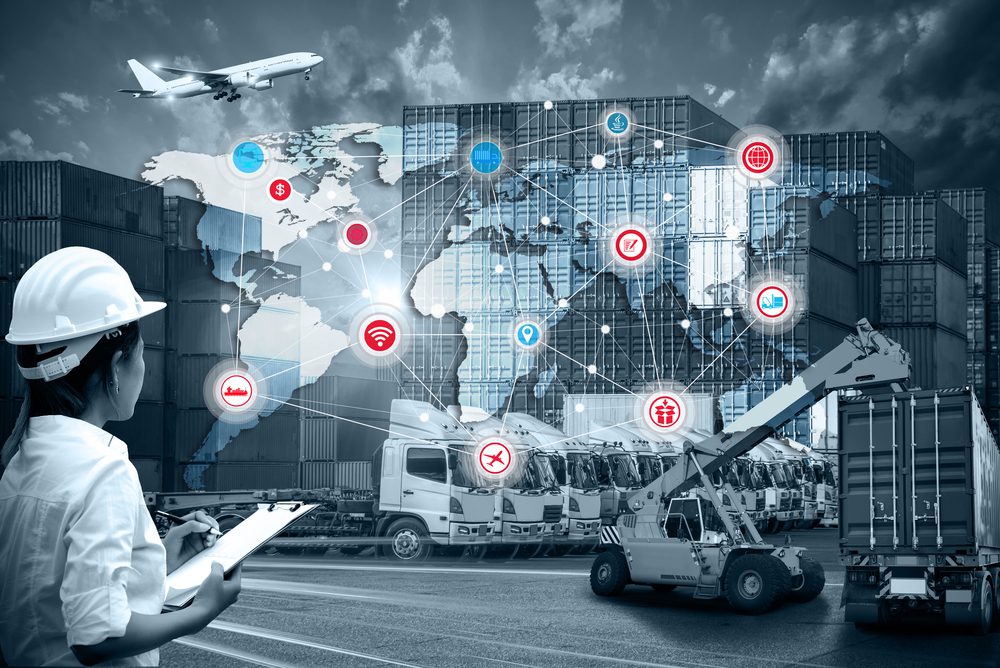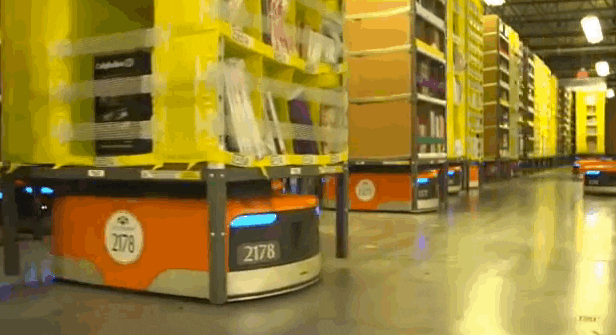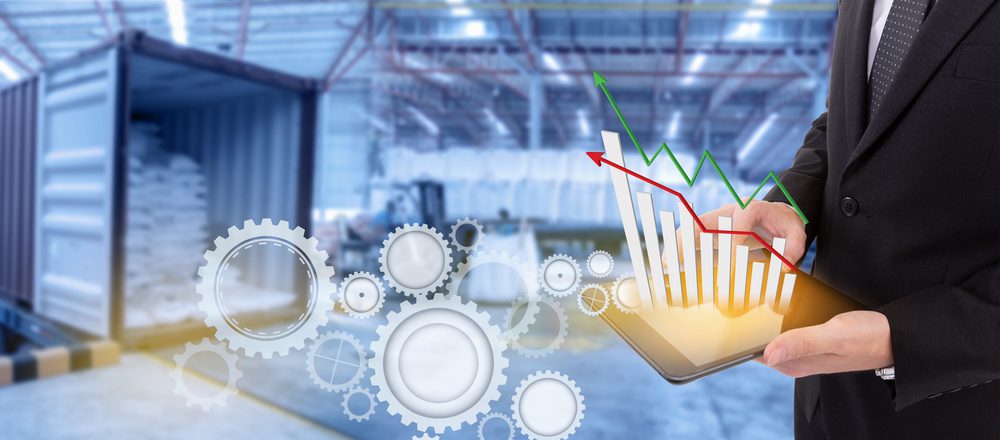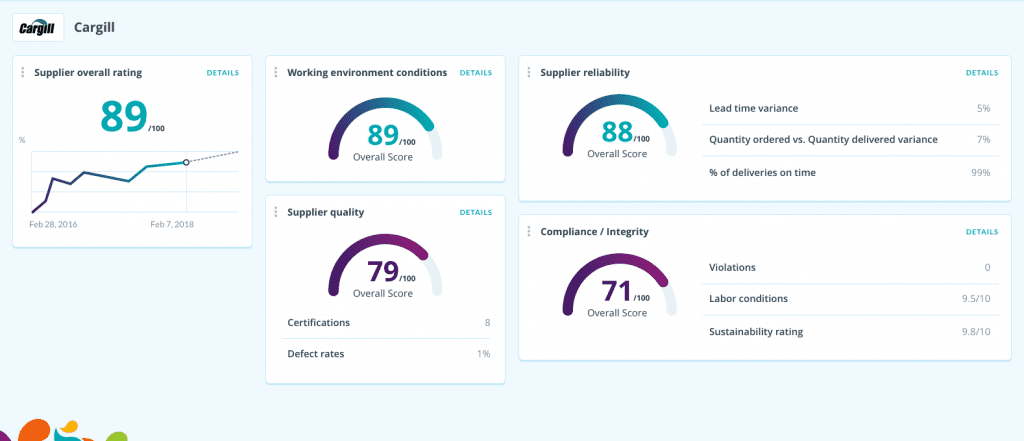
6 Reasons Executives Should Invest in AI in Supply Chain
For decades, our society has indulged itself in a fantastic, futuristic notion of artificial intelligence (AI). From robot servants to thinking computers, we’ve imagined all sorts of ways in which AI will play an important role in our lives (emphasis on will, not “could”).
We’ve been dreaming of a world in which our needs are met before we even know it. And let’s face it: who hasn’t at least briefly dreamed of that sleek looking flying car to take us away from endless hours spent in traffic?
What if I told you that artificial intelligence has already become, almost seamlessly, integrated into our lives? And that even if we don’t yet recognize it, it is already responsible for some amazing operational improvements across many companies around the world.
We’re talking about artificial intelligence for supply chain improvement. Or, in short, “AI in supply chain.”
AI in supply chain is all about leveraging artificial intelligence (AI) as a means of improving the supply chain process. More than a futuristic concept, AI is revolutionizing operational processes by interpreting large amounts of historical data and anticipating potential crises, such as a supply shortage or surplus.
In reality, supply chain improvements impact us in a very direct way, every single day of our lives. Talking about AI in supply chain management is incredibly timely.
Operational efficiencies in supply chain management are responsible for a reduction in the cost to serve us all. It helps maintain current prices for the products we love to buy. And, it allows us to get what we want faster than ever before. Read on for insights and how to improve your business from a leading AI & Emerging Technologies company.

 We all have hunches—the feeling that something is going to happen. At its core, a hunch is nothing more than an informed guess about what is to come, based on previous experiences & outcomes.
Computers can have hunches too. But their hunches can be significantly more advanced (and accurate).
Fact: computers can interpret massive amounts of data from your supply chain operations and make educated guesses on future performance based on past deliverables.
Nobody is saying these guesses are bulletproof. But they don’t need to be.
A prediction is just that: something we anticipate based on all we know from previous experiences to help us reasonably expect a specific outcome for comparable conditions and past results.
The ability for AI algorithms to learn from past data sets can transform how predictive analysis can shape decision-making in supply chain management. It will allow executives to work alongside AI to make efficient, informed decisions.
Machine learning can use realtime and past data to create likely or ideal scenarios for a given situation. For example, supply and demand can be monitored and predicted more accurately, keeping your business one-step-ahead at all times.
This kind of optimized machine learning can be used both in supply chain planning and in warehouse management. Better decisions can be made to minimize loss and boost efficiency and customer satisfaction.
We all have hunches—the feeling that something is going to happen. At its core, a hunch is nothing more than an informed guess about what is to come, based on previous experiences & outcomes.
Computers can have hunches too. But their hunches can be significantly more advanced (and accurate).
Fact: computers can interpret massive amounts of data from your supply chain operations and make educated guesses on future performance based on past deliverables.
Nobody is saying these guesses are bulletproof. But they don’t need to be.
A prediction is just that: something we anticipate based on all we know from previous experiences to help us reasonably expect a specific outcome for comparable conditions and past results.
The ability for AI algorithms to learn from past data sets can transform how predictive analysis can shape decision-making in supply chain management. It will allow executives to work alongside AI to make efficient, informed decisions.
Machine learning can use realtime and past data to create likely or ideal scenarios for a given situation. For example, supply and demand can be monitored and predicted more accurately, keeping your business one-step-ahead at all times.
This kind of optimized machine learning can be used both in supply chain planning and in warehouse management. Better decisions can be made to minimize loss and boost efficiency and customer satisfaction.
 This dashboard is made for illustrative purposes only and does not reflect actual data from Cargill or any other vendor.
In this proposed dashboard, all vendors can be graded based on historical data across a wide variety of metrics currently captured in your ERP system. In the screenshot above, we are illustrating how a company dealing with various vendors can access predictive analytics data points for each vendor they’re doing business with. And more importantly, you can predict future performance based on past activities.
This dashboard is made for illustrative purposes only and does not reflect actual data from Cargill or any other vendor.
In this proposed dashboard, all vendors can be graded based on historical data across a wide variety of metrics currently captured in your ERP system. In the screenshot above, we are illustrating how a company dealing with various vendors can access predictive analytics data points for each vendor they’re doing business with. And more importantly, you can predict future performance based on past activities.
 You may not have noticed, but Google Translate has been getting significantly better and better over the years at correctly translating from one language to another.
This, of course, allows people to translate, for free, different sentences, articles, or even entire websites from one language to another. But there’s another application that is particularly critical to supply chain executives.
Automatic translation and decision-making is one of the biggest breakthroughs AI technology offers to supply chain divisions. This AI innovation enables a computer to understand and interpret human conversation, whether that be tweets, news articles or huge sets of foreign data to help executives make decisions.
This is no small feat, with far-reaching implications.
Memorably, Apple had to publicly update its supply chain policies because, as it turns out, one of its suppliers was again sourcing materials used in iPhones that were the result of child labor. This, of course, is not the first time an incident like this happened. In fact, unfortunately for Apple, similar incidents have been prevalent over the last five years.
Here’s the problem with Apple’s changes to its supply chain policies: they’re all reactive. Supplier A does something bad. An American media outlet picks it up. Apple makes a policy change or takes a drastic measure like sacking the supplier.
Incorporating natural language processing into the supply chain process automatically allows you to do two things:
You may not have noticed, but Google Translate has been getting significantly better and better over the years at correctly translating from one language to another.
This, of course, allows people to translate, for free, different sentences, articles, or even entire websites from one language to another. But there’s another application that is particularly critical to supply chain executives.
Automatic translation and decision-making is one of the biggest breakthroughs AI technology offers to supply chain divisions. This AI innovation enables a computer to understand and interpret human conversation, whether that be tweets, news articles or huge sets of foreign data to help executives make decisions.
This is no small feat, with far-reaching implications.
Memorably, Apple had to publicly update its supply chain policies because, as it turns out, one of its suppliers was again sourcing materials used in iPhones that were the result of child labor. This, of course, is not the first time an incident like this happened. In fact, unfortunately for Apple, similar incidents have been prevalent over the last five years.
Here’s the problem with Apple’s changes to its supply chain policies: they’re all reactive. Supplier A does something bad. An American media outlet picks it up. Apple makes a policy change or takes a drastic measure like sacking the supplier.
Incorporating natural language processing into the supply chain process automatically allows you to do two things:
But first, what exactly is artificial intelligence?
In its simplest form, artificial intelligence is when a computer or computer-controlled device runs functions and performs tasks that would normally require human assistance. Depending on its use, this may require a computer to understand speech, have visual perception, or be able to make decisions independent of human intelligence (aka manual intervention). Many AI machines also have the ability to learn on their own and make decisions based on past events. Or, they can interpret massive amounts of data from a company’s supply chain history to predict future outcomes with amazing accuracy.Why should we care about AI in supply chain?
Supply chain refers to the process of producing and distributing certain goods and services. And just as artificial intelligence has made its way into healthcare and finance, it is now creating a fourth industrial revolution in supply chain management. A century ago, we had mechanization, the introduction of electricity into mass production, and now we have artificial intelligence. The artificial intelligence revolution is being called ‘Industry 4.0‘, where AI-driven machines monitor and control physical objects while making decentralized decisions based on specific parameters. But enough theory. In Part 1 of this two-part series, we’ll focus on the AI innovations currently available which have a direct and actionable impact on how supply chain executives can optimize and improve the procurement and product development process of supply chain management. We’re focusing, exclusively, on technologies available right now. Below is a set of ideas that every executive in supply chain can consider including in their digital strategy roadmap today.1. Reduce time spent on repetitive tasks
Advanced computer vision helps automate the manufacturing process.
Amazon automated product sorting robots are an early example of choosing the right products to be shipped out of a warehouse.
In the supply chain process, there is a tremendous amount of time wasted on manual checks, particularly when it comes to quality control. Think, for example, of Oreo cookies. Somehow, they manage to go from the factory to your dining table without crumbling. That’s because at the end of the day, there are people supervising the process of making, packaging, shipping, delivering, and adding those products to the shelves of your local grocery store. It’s not magic. It’s people. People who have to supervise those Oreo cookies to make sure you get what you paid for. But more importantly, it’s wasted time, talent, and money. The reality is simple. The production process and quality control may not yet be fully automated. Still, as Andrew Ng, creator of the Google Brain project, notes, factory quality control is where AI can “bring digital transformation to the physical world.” What’s happening in this space, you may ask? Although still in an incipient stage, various companies have successfully used computer vision aided by convolutional neural networks (CNNs). In a factory setting, CNNs can “automatically learn what distinguishes good parts from not good parts on an assembly line with incredible speed.” Specifically in our case, this AI technology can detect a bad Oreo from a good Oreo. And even remove it off the production assembly line. All without a single person looking at it. Computer vision, where an automated machine can detect good versus bad part production, is the first step towards end-to-end automation. When computer vision algorithms become more refined in their accuracy, this technology will help reduce the cost to serve while increasing product accuracy and speed to market. But for now, what supply chain executive wouldn’t like for that bad Oreo to be removed automatically? That’s why AI in supply chain is an important topic that we should begin discussing.2. Make informed decisions based on historical records about future outcomes
What if you could predict how your suppliers will perform based on specific conditions like supply shortages, natural disasters, political unrest or other factors? As it turns out, you can! We all have hunches—the feeling that something is going to happen. At its core, a hunch is nothing more than an informed guess about what is to come, based on previous experiences & outcomes.
Computers can have hunches too. But their hunches can be significantly more advanced (and accurate).
Fact: computers can interpret massive amounts of data from your supply chain operations and make educated guesses on future performance based on past deliverables.
Nobody is saying these guesses are bulletproof. But they don’t need to be.
A prediction is just that: something we anticipate based on all we know from previous experiences to help us reasonably expect a specific outcome for comparable conditions and past results.
The ability for AI algorithms to learn from past data sets can transform how predictive analysis can shape decision-making in supply chain management. It will allow executives to work alongside AI to make efficient, informed decisions.
Machine learning can use realtime and past data to create likely or ideal scenarios for a given situation. For example, supply and demand can be monitored and predicted more accurately, keeping your business one-step-ahead at all times.
This kind of optimized machine learning can be used both in supply chain planning and in warehouse management. Better decisions can be made to minimize loss and boost efficiency and customer satisfaction.
We all have hunches—the feeling that something is going to happen. At its core, a hunch is nothing more than an informed guess about what is to come, based on previous experiences & outcomes.
Computers can have hunches too. But their hunches can be significantly more advanced (and accurate).
Fact: computers can interpret massive amounts of data from your supply chain operations and make educated guesses on future performance based on past deliverables.
Nobody is saying these guesses are bulletproof. But they don’t need to be.
A prediction is just that: something we anticipate based on all we know from previous experiences to help us reasonably expect a specific outcome for comparable conditions and past results.
The ability for AI algorithms to learn from past data sets can transform how predictive analysis can shape decision-making in supply chain management. It will allow executives to work alongside AI to make efficient, informed decisions.
Machine learning can use realtime and past data to create likely or ideal scenarios for a given situation. For example, supply and demand can be monitored and predicted more accurately, keeping your business one-step-ahead at all times.
This kind of optimized machine learning can be used both in supply chain planning and in warehouse management. Better decisions can be made to minimize loss and boost efficiency and customer satisfaction.
Machine Learning and ROI
We’re not alone in believing this. In fact, Vice President of Hitachi Insight Group, Greg Kinsey, believes this kind of intelligent predictive analysis can increase efficiency in a supply chain by 10 percent. According to the Telegraph, implementing machine learning to optimize manufacturing could see a ROI of 3:1. At Digital Authority Partners, we work on new AI in supply chain concepts and ideas every day. For example, we recently proposed a new AI concept to a consumer packaged goods company. Our premise is simple: we can look at past vendor performance to predict how a vendor will perform across a wide variety of metrics, including quality, compliance, reliability, work environment conditions and lead time variance. What if your company could have access to a similar dashboard, as seen below: This dashboard is made for illustrative purposes only and does not reflect actual data from Cargill or any other vendor.
In this proposed dashboard, all vendors can be graded based on historical data across a wide variety of metrics currently captured in your ERP system. In the screenshot above, we are illustrating how a company dealing with various vendors can access predictive analytics data points for each vendor they’re doing business with. And more importantly, you can predict future performance based on past activities.
This dashboard is made for illustrative purposes only and does not reflect actual data from Cargill or any other vendor.
In this proposed dashboard, all vendors can be graded based on historical data across a wide variety of metrics currently captured in your ERP system. In the screenshot above, we are illustrating how a company dealing with various vendors can access predictive analytics data points for each vendor they’re doing business with. And more importantly, you can predict future performance based on past activities.
Example of Supply Chain and Machine Learning
IBM’s Watson Supply Chain is a prime example of how machine learning is already evolving the way the world manages production. IBM Watson is forecasting supply chain disruptions using a web of in-depth data, including external information from sources such as weather forecasts, the news, and social media platforms. Companies can then use this technology in their own production and supply chain monitoring operations, minimizing what were previously ‘unforeseen circumstances’ that cause downtime, and instead concentrating on increasing efficiency.3. Make informed decisions based on automated alerts around points of failure in the supply chain production process
You can now use AI to interpret data & provide next steps in the manufacturing process if something goes wrong. You can even automate the suggestions on how to fix an issue. We talked about predicting the future using AI. But the reality is that there is a significantly more tangible AI application than simply acting on alerts and notifications which are automated based on specific “if this then that” rules. Say, for example, that you work in the oil and gas industry. Your process of extracting, processing, delivering and selling natural gas needs to follow specific protocols – some self imposed, some imposed by the governments of the countries you operate in. If something goes wrong at a factory, big oil companies are relying on thousands of technical experts to review existing protocols and to fix a specific issue. Depending on what’s wrong, an oil company needs to make different decisions: dispatch a technician, a supervisor—even notify the government and ask for an EPA inspector to visit a facility before resuming production. These decisions are made based on a finite list of potential issues that exist at an oil well or refinery factory. Because these issues are known, the current process involves dispatching specific people to inspect, fix and check on the issues identified. However, some companies are already taking the next logical step. Rather than relying on people to figure out what’s wrong and how to fix it, Sinopec, one of the largest oil refining companies in the world, is investing in Artificial Intelligence algorithms to provide insights, warnings and automated recommendations to factory workers. These algorithms are going to alert the appropriate personnel with critical information that will facilitate the decision-making process and inform what should happen next. This is something every supply chain executive should consider investing in. After all, it’s a universal problem: so many things that can go wrong. Based on automated alerts, you can automatically notify the right people and even suggest the appropriate next steps to solve an issue. Can you imagine how much time and effort can be saved in the oil and gas refinery process if any company in this space invested in this basic AI-driven optimization?4. Use natural language processing to monitor your suppliers across borders with AI in supply chain algorithms
Natural language processing (NLP) allows you to automatically monitor your suppliers by aggregating news about them from all over the world, then automatically translating it into English. You may not have noticed, but Google Translate has been getting significantly better and better over the years at correctly translating from one language to another.
This, of course, allows people to translate, for free, different sentences, articles, or even entire websites from one language to another. But there’s another application that is particularly critical to supply chain executives.
Automatic translation and decision-making is one of the biggest breakthroughs AI technology offers to supply chain divisions. This AI innovation enables a computer to understand and interpret human conversation, whether that be tweets, news articles or huge sets of foreign data to help executives make decisions.
This is no small feat, with far-reaching implications.
Memorably, Apple had to publicly update its supply chain policies because, as it turns out, one of its suppliers was again sourcing materials used in iPhones that were the result of child labor. This, of course, is not the first time an incident like this happened. In fact, unfortunately for Apple, similar incidents have been prevalent over the last five years.
Here’s the problem with Apple’s changes to its supply chain policies: they’re all reactive. Supplier A does something bad. An American media outlet picks it up. Apple makes a policy change or takes a drastic measure like sacking the supplier.
Incorporating natural language processing into the supply chain process automatically allows you to do two things:
You may not have noticed, but Google Translate has been getting significantly better and better over the years at correctly translating from one language to another.
This, of course, allows people to translate, for free, different sentences, articles, or even entire websites from one language to another. But there’s another application that is particularly critical to supply chain executives.
Automatic translation and decision-making is one of the biggest breakthroughs AI technology offers to supply chain divisions. This AI innovation enables a computer to understand and interpret human conversation, whether that be tweets, news articles or huge sets of foreign data to help executives make decisions.
This is no small feat, with far-reaching implications.
Memorably, Apple had to publicly update its supply chain policies because, as it turns out, one of its suppliers was again sourcing materials used in iPhones that were the result of child labor. This, of course, is not the first time an incident like this happened. In fact, unfortunately for Apple, similar incidents have been prevalent over the last five years.
Here’s the problem with Apple’s changes to its supply chain policies: they’re all reactive. Supplier A does something bad. An American media outlet picks it up. Apple makes a policy change or takes a drastic measure like sacking the supplier.
Incorporating natural language processing into the supply chain process automatically allows you to do two things:
- Translate news about your suppliers from other languages into English.
- Proactively find out if your suppliers are engaged in certain activities that go against your terms of service.
5. Use chatbots to effectively manage your supply chain process
Chatbots can effectively be deployed to answer your suppliers’ frequent questions, get shipping and delivery updates, and send notifications about governance and compliance requirements. As a whole, chatbots represent one of the most underrated pieces of AI technology. Not because they cannot work. But because a chatbot is only as smart as the person behind it. And unfortunately, many people who have built and deployed chatbots thus far haven’t been exactly smart in their implementation. It is why, even today, we continue to see articles about the shortcomings of chatbots — but they tend to miss the point.The Power of Chatbots
Chatbots are pieces of software which interpret human input (text or speech) and attempt to provide an automated solution. Through detailed, tailored code, you can build a bot to deal with supplier questions and concerns and reduce the amount of manpower needed to be effective. Using chatbots also puts the control of supplier relationship management back in your hands, helping to make response times quicker and reduce human error. The implications of chatbot technology are enormous for supply chain. Let’s take the example of a consumer packaged goods company like Kraft Heinz (the maker of our favorite ketchup and mustard that can be found at practically every US food store). For an optimal supply chain, Kraft Heinz would need processes to support constant communication across their entire supply chain entities, at all times. In their current state, Kraft Heinz sits at the middle of an enormous communication and decision making process and would need a robust, interactive communication channel to track:- Worldwide suppliers of raw materials (behind the products being built; i.e. tomatoes for ketchup)
- Manufacturing plant staff (where delicious ketchup is made)
- Outbound logistics and warehouse distribution (someone has to package and get the ketchup ready for action)
- Transportation to retailers (Santa brings ketchup to the store)
- Retailers (where I eagerly buy my ketchup)
- Communicate with suppliers and distributors about time-sensitive events with limited human intervention (interruptions in service, delivery delays, overdue bills etc)
- Get updates from suppliers of raw materials on unforeseen delays (weather conditions, production shortages and more)
- Send upstream or downstream notifications about governance and compliance requirements (to both suppliers and distributors/ retail clients)
- Allow retail clients to request status updates (on Kraft Heinz deliveries, payment terms, outstanding contracts and more)
6. Use anticipatory logistics to predict product demand and improve supply chain planning
Anticipatory logistics can predict product demand so that you can order the right number of materials from your suppliers before you need them. In a supply chain, materials, tools and products are shipped in from a variety of suppliers. This means that to build your product, you need to have each separate component from each separate supplier shipped in advance, on time. You can start to see how this might become a problem. Let’s take a closer look. If you’re making ketchup, you need to have a specific set of raw materials to create your product. You need the fancy bottle from one supplier, vinegar from another, and tomatoes from – you guessed it – a third supplier. And that doesn’t even include certain seasonings/ spices you may use in addition to the basic ingredients. But you see my point, right? You need your tomatoes, vinegar, bottles etc to arrive at more or less the same time so that you can create your ketchup on schedule. Order too many materials and you’re stuck with a warehouse full of stock. Order too little and you’re stuck with a whole lot of disgruntled customers who will buy a different brand of ketchup when yours sell out. You need to know the right quantity of materials to order based on projected sales.Define: Anticipatory Logistics
Enter anticipatory logistics. Anticipatory logistics uses predictive AI technology to help you take control of the ordering and distribution of your products. Using data from past orders, as well as analysis of current sales, customer browsing history, wish-lists and more, anticipatory logistics can make a logical estimation of how many products you’re going to sell, then order the right amount of materials needed from suppliers to be delivered on time, in the quantity needed, for the products you’re distributing. This eliminates excess materials and products while ensuring you have the right quantity of inventory to keep sales high. In short, anticipatory logistics allows your supply chain to function with better performance and lower costs. But it doesn’t stop here. Anticipatory logistics also allows you to plan your delivery process based on accurate quantities, enables your supply chain to run smoother, and even helps you confidently market your services to your customers. Anticipatory logistics is not new. This system is so efficient and reliable that even the US army has been using it in their highly controlled supply chains to maintain an optimum level of munitions, fuel and maintenance. And then there’s Amazon, a pioneer of anticipatory shipping. Regardless of where or how it’s used, anticipatory logistics can help transform your company’s supply chain into a highly organized system that receives, builds, and ships products at the right time—and to the right people—to increase efficiency, boost customer satisfaction, and provide significant cost-savings.Bottomline: Make This Year The Year You Invest in AI
AI is here to stay. So make use of it. Today. The dramatic improvement of programming languages, protocols and algorithms have yielded more diverse applications with better results than ever before. The original time lag is dropping, however. While in 2018 only 7% of manufacturing and service companies are using AI to automate production activities, that’s no longer the case. Today, over 70% of manufacturers are looking to invest in machine learning and AI tools. Don’t fall behind: You build smart — let the smart tools help. Applying AI to your supply chain management process can yield massive, quantifiable results:- AI reduces the time spent on manual labor, freeing employees to make more valuable contributions to your business.
- AI allows you to make better, more informed decisions based on prior historical data.
- AI provides critical alerts and recommendations for when things go wrong.
- AI helps you monitor suppliers in other regions of the world to proactively prevent problems.
- AI simplifies supply chain relationship management.
- AI helps you optimize your supply chain processes to increase customer satisfaction and generate more profit for your business.
- AI can help detect fraud
- AI integrations can help companies budget effectively.
Want To Meet Our Expert Team?
Book a meeting directly here

